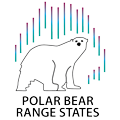 Photo credit: U.S. Fish and Wildlife ServiceIn 1973, Canada, Denmark, Norway, the United States and the Union of Soviet Socialist Republics signed the Agreement on the Conservation of Polar Bears. The representatives of the Parties (Canada, Greenland, Norway, Russia and the United States) note that at that time the largest threat to the polar bear (Ursus maritimus) was over-hunting, which had led to the severe depletion of some of the subpopulations within their range. As a result of coordinated international efforts and effective management actions by the Range States, polar bear numbers in some previously depressed populations have grown.
Photo credit: U.S. Fish and Wildlife ServiceIn 1973, Canada, Denmark, Norway, the United States and the Union of Soviet Socialist Republics signed the Agreement on the Conservation of Polar Bears. The representatives of the Parties (Canada, Greenland, Norway, Russia and the United States) note that at that time the largest threat to the polar bear (Ursus maritimus) was over-hunting, which had led to the severe depletion of some of the subpopulations within their range. As a result of coordinated international efforts and effective management actions by the Range States, polar bear numbers in some previously depressed populations have grown.
History of the Agreement
The need for an international convention or agreement on polar bear conservation was originally recognized and pursued in 1965 by delegates from the United States, Canada, Denmark, Norway, Switzerland and the Soviet Union. Increased hunting of polar bears had led to severe pressure on the species in some regions of the Arctic, and there was a recognized need for improved management of the species. The preparations for an agreement were facilitated by the International Union for Conservation of Nature (IUCN), in consultation with the respective governments. The IUCN/ Species Survival Commission (IUCN/SSC) Polar Bear Specialist Group (PBSG) was formed following a request for the IUCN to provide information on effective management practices for polar bear. The Agreement was signed in Oslo on November 15, 1973, and entered into force on May 26, 1976. According to the Agreement, the Range States recognize that the polar bear is a significant resource of the Arctic region that requires protection. By signing the Agreement, the Range States agreed to undertake coordinated action pertaining to the management of polar bears throughout the circumpolar range. Since that time, ongoing collaboration among the Range States has largely eliminated the initial primary threat: overharvesting. Range State collaboration through the Agreement has also facilitated the signature of bilateral cooperative arrangements that are now in place for most shared populations.
Recognizing the success of the Agreement, the parties celebrated its 40th anniversary by participating in the International Forum on the Conservation of Polar Bears in Moscow, Russia in December 2013. At that forum, representatives of the parties of the Agreement reaffirmed their commitment to take collaborative action on conserving the polar bear by signing a Declaration of the Responsible Ministers of the Polar Bear Range States. Highlights of the 2013 Declaration include recognition that the Range States share responsibility for conservation and research actions, that the polar bear is an important global resource and an indicator of biological health in the Arctic, that addressing climate change is going to be essential for the long-term conservation of the species, and that the best available information should be shared and taken into account during decision-making. It also acknowledged the important continued role of the IUCN/SSC PBSG as the scientific advisory body for the Range States.
One of the objectives of the Circumpolar Action Plan is to minimize threats to polar bears and their habitat through adaptive polar bear management based on coordinated research and monitoring efforts. These initiatives need to be taken at broad levels—circumpolar, bilateral and domestic —as appropriate, and with the engagement of indigenous peoples.
Over the past 40 years, considerable progress has been made to establish domestic and inter-jurisdictional arrangements for polar bear research and management. Many of these arrangements have been formalized through legally binding and non-binding instruments. As a result of the ongoing concerted effort of all Range States, and with the support of the IUCN, an effective polar bear management regime has emerged.
Source: Circumpolar Action Plan
